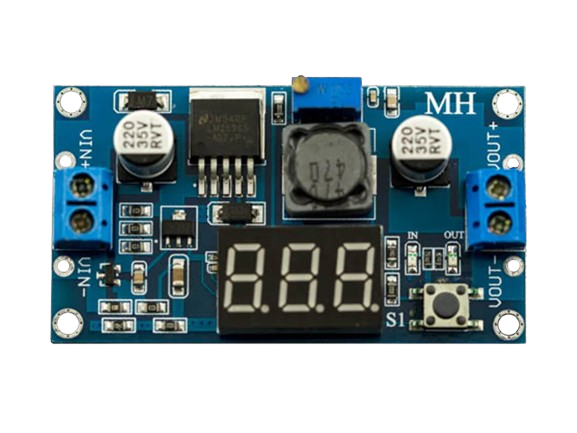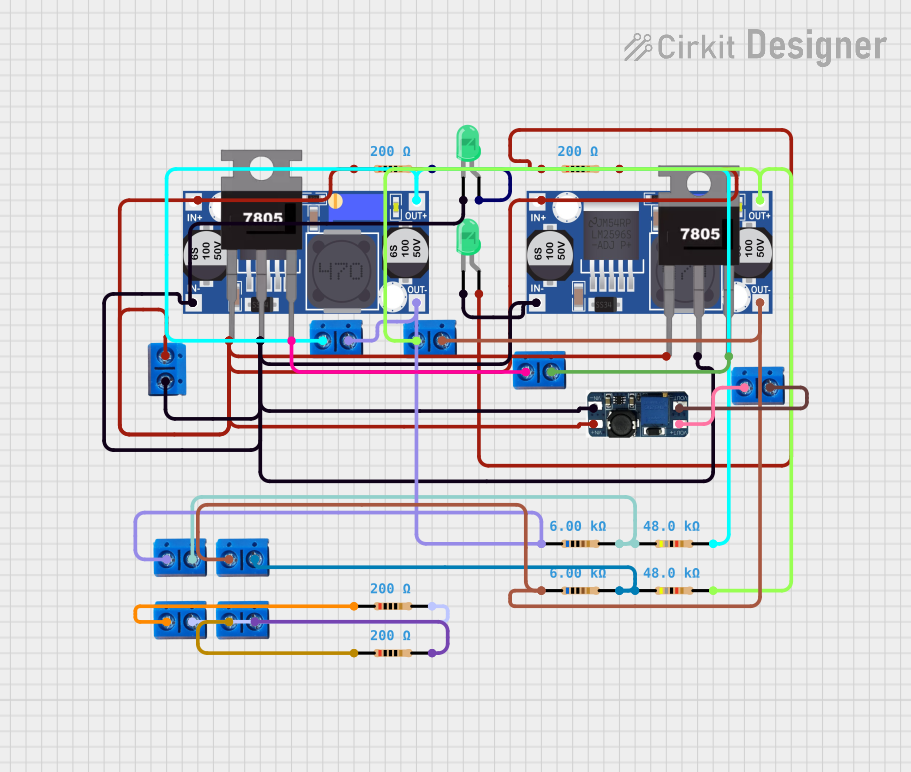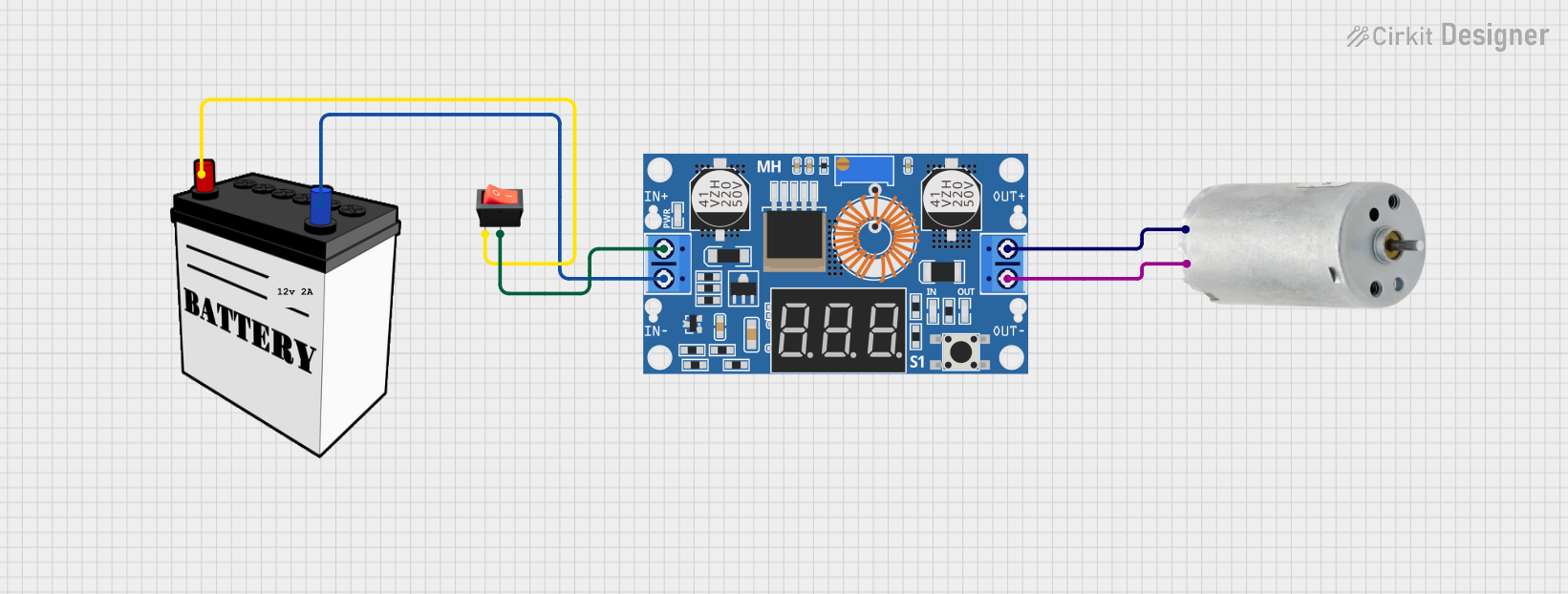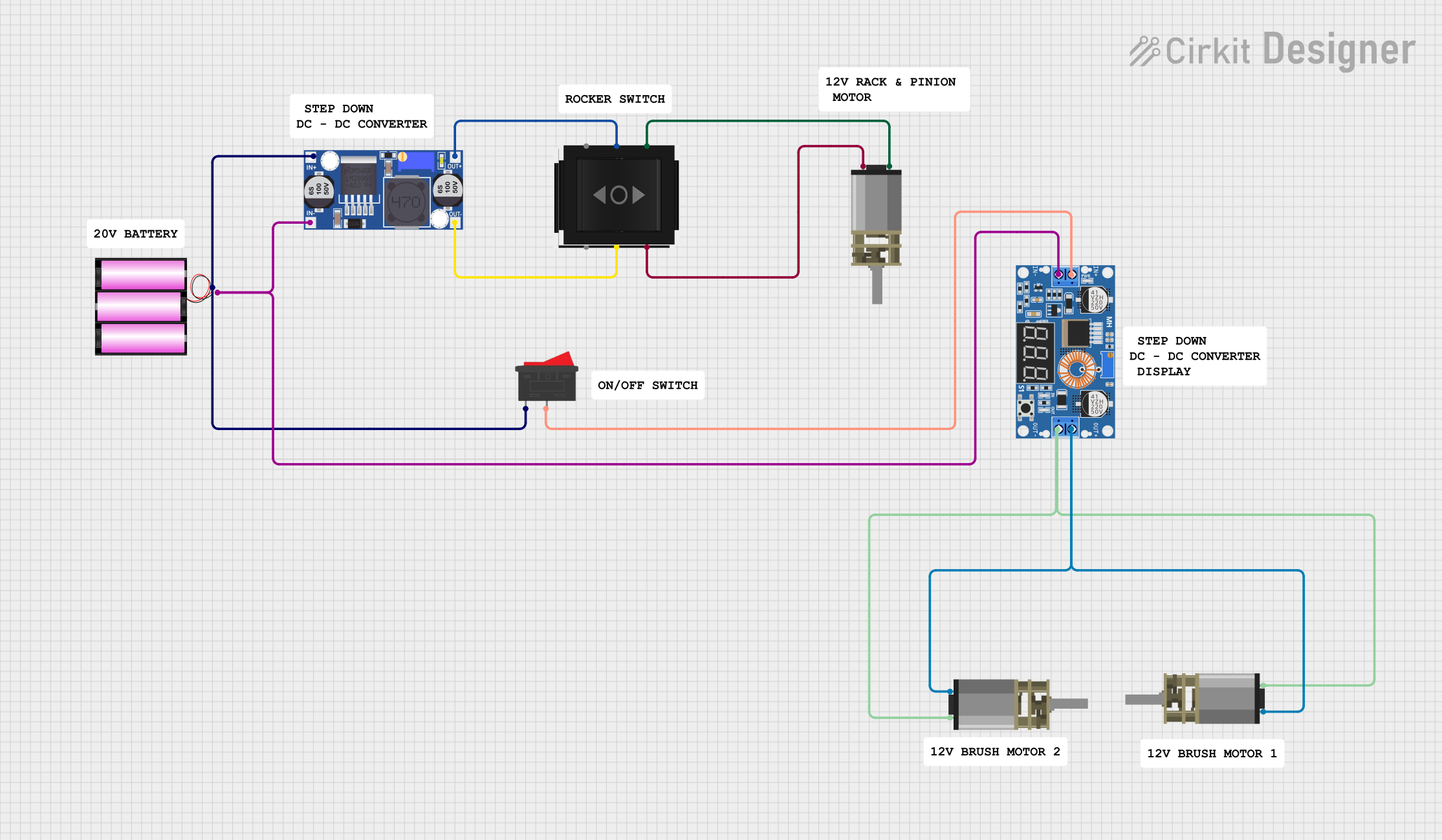
How to Use dc-dc buck converter: Examples, Pinouts, and Specs

 Design with dc-dc buck converter in Cirkit Designer
Design with dc-dc buck converter in Cirkit DesignerIntroduction
A DC-DC buck converter is a type of power converter designed to step down voltage from a higher level to a lower level while maintaining high efficiency. It achieves this by using a combination of a switching element (such as a transistor), an inductor, a diode, and a capacitor. The buck converter is widely used in applications where efficient power management is critical.
Explore Projects Built with dc-dc buck converter

 Open Project in Cirkit Designer
Open Project in Cirkit Designer
 Open Project in Cirkit Designer
Open Project in Cirkit Designer
 Open Project in Cirkit Designer
Open Project in Cirkit Designer
 Open Project in Cirkit Designer
Open Project in Cirkit DesignerExplore Projects Built with dc-dc buck converter

 Open Project in Cirkit Designer
Open Project in Cirkit Designer
 Open Project in Cirkit Designer
Open Project in Cirkit Designer
 Open Project in Cirkit Designer
Open Project in Cirkit Designer
 Open Project in Cirkit Designer
Open Project in Cirkit DesignerCommon Applications and Use Cases
- Powering low-voltage devices from higher-voltage sources (e.g., 12V to 5V conversion)
- Battery-powered devices such as smartphones, laptops, and portable electronics
- Voltage regulation in embedded systems and microcontrollers
- Renewable energy systems, such as solar power setups
- Automotive electronics for powering subsystems
Technical Specifications
Below are the general technical specifications for a typical DC-DC buck converter. Note that specific values may vary depending on the model and manufacturer.
Key Technical Details
- Input Voltage Range: 4.5V to 40V (varies by model)
- Output Voltage Range: 1.25V to 37V (adjustable in most models)
- Output Current: Up to 3A (or higher for certain models)
- Efficiency: Up to 95% (depending on load and input/output conditions)
- Switching Frequency: 150 kHz to 1 MHz (varies by design)
- Operating Temperature: -40°C to +85°C (typical)
Pin Configuration and Descriptions
The pinout of a DC-DC buck converter module may vary depending on the design, but a common configuration is as follows:
| Pin Name | Description |
|---|---|
| VIN | Input voltage pin. Connect the higher voltage source to this pin. |
| GND | Ground pin. Connect to the ground of the input and output circuits. |
| VOUT | Output voltage pin. Provides the stepped-down voltage to the load. |
| EN (optional) | Enable pin. Used to turn the converter on or off (active high in most designs). |
| ADJ (optional) | Adjustment pin. Used to set the output voltage (via a potentiometer or resistor). |
Usage Instructions
How to Use the Component in a Circuit
- Connect the Input Voltage:
- Attach the positive terminal of the input voltage source to the
VINpin. - Connect the negative terminal of the input source to the
GNDpin.
- Attach the positive terminal of the input voltage source to the
- Set the Output Voltage:
- If the module has an adjustable output, use the onboard potentiometer or external resistor to set the desired output voltage.
- Measure the output voltage using a multimeter to ensure accuracy.
- Connect the Load:
- Attach the positive terminal of the load to the
VOUTpin. - Connect the negative terminal of the load to the
GNDpin.
- Attach the positive terminal of the load to the
- Enable the Converter (if applicable):
- If the module has an
ENpin, ensure it is connected to a high logic level (e.g., 3.3V or 5V) to enable the converter.
- If the module has an
Important Considerations and Best Practices
- Input Voltage Range: Ensure the input voltage is within the specified range of the module to avoid damage.
- Heat Dissipation: For high-current applications, consider adding a heatsink to the module to prevent overheating.
- Output Filtering: Use additional capacitors at the output if the load is sensitive to voltage ripple.
- Current Limit: Do not exceed the maximum output current rating of the module to avoid damage.
- Polarity: Double-check the polarity of the input and output connections to prevent reverse polarity damage.
Example: Using a Buck Converter with Arduino UNO
Below is an example of how to use a DC-DC buck converter to power an Arduino UNO from a 12V source:
- Connect the 12V source to the
VINandGNDpins of the buck converter. - Adjust the output voltage to 5V using the onboard potentiometer.
- Connect the
VOUTpin of the buck converter to the5Vpin of the Arduino UNO. - Connect the
GNDpin of the buck converter to theGNDpin of the Arduino UNO.
Sample Code for Arduino UNO
// Example code to blink an LED connected to pin 13 of Arduino UNO
// Ensure the Arduino is powered via the buck converter (5V output).
void setup() {
pinMode(13, OUTPUT); // Set pin 13 as an output pin
}
void loop() {
digitalWrite(13, HIGH); // Turn the LED on
delay(1000); // Wait for 1 second
digitalWrite(13, LOW); // Turn the LED off
delay(1000); // Wait for 1 second
}
Troubleshooting and FAQs
Common Issues and Solutions
No Output Voltage:
- Check the input voltage to ensure it is within the specified range.
- Verify that the
ENpin is connected to a high logic level (if applicable). - Inspect the connections for loose wires or incorrect polarity.
Output Voltage is Incorrect:
- Adjust the potentiometer or external resistor to set the correct output voltage.
- Measure the input voltage to ensure it is stable and sufficient.
Overheating:
- Ensure the load current does not exceed the module's maximum rating.
- Add a heatsink or improve ventilation around the module.
High Voltage Ripple:
- Add additional filtering capacitors at the output.
- Check the load for sudden current spikes that may cause instability.
FAQs
Q: Can I use a buck converter to power a microcontroller directly?
A: Yes, as long as the output voltage is set to match the microcontroller's operating voltage (e.g., 3.3V or 5V).
Q: What happens if I exceed the input voltage range?
A: Exceeding the input voltage range can damage the module. Always ensure the input voltage is within the specified range.
Q: Can I use a buck converter for AC input?
A: No, a buck converter is designed for DC input only. Use a rectifier and filter circuit to convert AC to DC before using the buck converter.
Q: How do I calculate the efficiency of the buck converter?
A: Efficiency can be calculated using the formula:
[
\text{Efficiency} (%) = \left( \frac{\text{Output Power}}{\text{Input Power}} \right) \times 100
]
Measure the input and output voltages and currents to determine power.
By following this documentation, you can effectively use a DC-DC buck converter in your projects while avoiding common pitfalls.